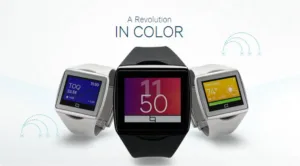Wearable devices were a major topic at CES with many companies showing products for this developing market. Qualcomm, as one of the key suppliers for mobile devices today, has a natural interest in all products that will influence and interact with smartphones. While wearable devices were not the most important topic for the Qualcomm press conference, they were at least mentioned briefly during the presentation.
On the other hand, Qualcomm has a new business unit for wearable devices, headed by Pankaj Kedia. Sean Hollister from Gizmodo had a chance to interview the new wearables boss at Qualcomm. In his article Pankaj Kedia points out that wearables are not a fad and won’t go away any time soon. He also stated that Qualcomm already delivers chips for 15 devices sold in 30 countries.
When questioned why he thinks that wearables will be successful in the future, there was no real clear message other than this is just the beginning of the wearable device market. While one can easily follow this logic, it also shows the status of the whole wearable industry today. Many new players with a single great idea are trying to market their respective devices. As with any new category, nobody other than the ultimate winner really knows how the consumer will react to the product.
In the recent past, Apple won the new product crown by having success with two successive product introductions, but market success with new products is hard to predict at best. Who wins today may not win tomorrow. Even being the first and, arguably, offering some of the best products available does not let you own the market for an extended period of time. Other players will take the idea and offer it for less until they get a healthy portion of the market, as happened with the smartphone and tablet. So, even if Apple does bring the consumer attention to the wearable market with its Apple Watch, there will be plenty of other businesses competing with the firm from the beginning.
This is where Qualcomm comes in. While the company did come to market with its own smartwatch, Toq, in 2013, the commercial success was more limited, even though Qualcomm did not release any actual sales numbers. A $100 price drop indicates that Qualcomm was not supply limited for this device. While the Toq was, of course, of great interest for us, based as it is on the use of the Mirasol display, it may not be indicative of Qualcomm’s direction in the wearable market going forward.
As the Inquirer reports from the CES press conference, it got a different vibe from the Qualcomm presentation: “Qualcomm thinks wearables aren’t ready for prime time yet“. The Inq sees a more cautious approach to the market, with many brands inside and outside the consumer electronics industry looking into a potential market opportunity.
Qualcomm is a chip supplier and will gladly sell to everyone who wants to make a wearable device. As Qualcomm points out, there will be more than just a good processor needed to make wearables work, there are requirements for power efficiency, better battery technology including fast charging, sensor technology, flexibility and others.
In addition, this time Intel does not want to just sit on the sidelines but has already shown with cooperation agreements that it will invest in the necessary technology. This competition between Qualcomm and Intel may actually help the wearable device designer to get better components early on, even with a relatively limited market success. (NH)
Booth Tour
As you would expect, on its booth Qualcomm was highlighting the Snapdragon 810 (Snapdragon 810 Unlocks Powerful Mobiles). The peformance is impressive and will allow the development of UltraHD tablets.
Qualcomm has also been a partner of StreamTV and the firm had a demonstration of its AS3D technology. (StreamTV Pushed Glasses-Free 3D Forward).
We plan a deeper dive with Qualcomm at the forthcoming MWC show.

